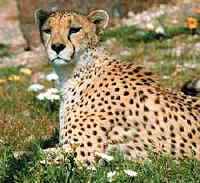Phoenix Zoo
2007 Schools Wikipedia Selection. Related subjects: North American Geography
| Phoenix Zoo | |
 Main entrance
|
|
| Date opened | November 1962 |
| Location | Phoenix, Arizona, USA |
| Land area | 125 acres (0.51 km²) |
| # of Animals | 1,200 |
| Accreditations/ Memberships |
AZA |
| Website | |
|
|
|
The Phoenix Zoo, opened in 1962, is the largest non-profit zoo in the United States. Located in Phoenix, Arizona, the zoo operates on 125 acres of land in the Papago Park area of Phoenix. It has been designated as a Phoenix Point of Pride.
The zoo has approximately 1,200 animals on display, 2.5 miles (4.0 km) of walking trails, and other attractions. It was founded by Robert Maytag, a member of the famous Maytag family.
History
The Phoenix Zoo began as a personal project of Maytag's, who formed the Arizona Zoological Society with the intention of opening a zoo in Phoenix. Although Maytag died a few months before the opening, the zoo opened on schedule in November of 1962. It was originally named the "Maytag Zoo", but was renamed the following year to its current name to give it a heightened sense of community. The zoo has been a privately owned, non-profit venture since it opened.
While the zoo initially has some financial struggles in the 1960's, it grew substantially during the 1970's as it added numerous new exhibits, landscaping features, and visitor amenities. The 1980's saw continued growth, with the addition of African Savanna habitat areas, a children's zoo, a new entrance complex, and other exhibits. During this time, the zoo also underwent a renovation project to divide it into four "trails", themed zones that feature different types of exhibits.
In 1998, the zoo significantly expanded again with the opening of Harmony Farms, home to a petting zoo and many domestic farm animals.
Areas and attractions
The Phoenix Zoo is made up of four major themed areas, or "trails", where visitors can experience exhibits representing different areas of the world and their native wildlife: the Arizona Trail, the Africa Trail, the Tropics Trail, and the Discovery/Children's Trail. There are also side trails including the Desert Lives Trail (featuring native Big Horn Sheep and Arabian Oryx amongst the natural buttes) and the Forest of Uco (featuring a mock South American mercado, a fake scientific expedition and ruins, and highlighting a number of tropical animals including the Spectacled Bear).
The Arizona Trail is designed to emulate the wildlife and plant life of the state of Arizona. It features several plants native to the Sonoran Desert including the saguaro cactus, and animals such as the coyote, collared peccary (more commonly known as the Javelina), mountain lion, bobcat, bald eagle, raven, turkey vulture, coati, thick billed parrot, Sonoran pronghorn, and the mexican grey wolf.
The Africa Trail showcases many of the most popular animals in the world, including the cheetah, African Wild Dogs, baboon, mandrill, ostrich, Mhorr gazelle, White Rhino, meerkats, African Lions, and Sumatran Tigers. The Desert Lives (pronounced like "life") trail diverts off of the Africa Trail before and after the lion and tiger exhibits.
The Tropics Trail has two parts. The inner trail following the lake is home to the Tropical Flights aviary as well as the ringtailed lemurs, and orangutans who recently brought a new baby, Kasih, into the world. The outer tropics trail passes by Asian elephants, black jaguar, Galapagos and Aldabra tortoises, iguanas, capybaras, anteaters, Chacoan peccary, and an assortment of other tropical birds. The outer tropics trail also includes the Forest of Uco and a maze for children.
The Discovery/Children's Trail has many animals that children as well as adults will enjoy seeing, and usually very close-up including an ocelot, a caracal, an Indian crested porcupine, racoons, Siamang gibbons, and golden-mantled tamarins. Continuing on the trail though will take you through Harmony Farms, a large farm area featuring all the favorite farm animals, a petting zoo, and demonstrations on farming and agriculture oriented toward children.
In addition to the trails, several attractions have appeared over the past few years. An endangered species carousel is featured in the entrance plaza. The zoo also has a wide array of youth programs, animal encounters, and specialty attractions such as the Safari Train, the custom animal carousel, and various retail outlets.
Conservation efforts
Since opening, the Phoenix Zoo has had a reputation for focusing on animal conservation efforts. During its first year of operation, the zoo was home to a captive breeding program involving the last seven known Arabian oryx. By 1980, more than a hundred of the oryx had been born at the zoo, which literally brought them back from near-extinction. Of the Arabian oryx that exist today, almost all of them can be traced back to the Phoenix Zoo.
In conjunction with the American Zoo and Aquarium Association, the zoo has participated in the Species Survival Plan (SSP). The goal of the SSP is to engage in animal husbandry and research projects for selected species that are in need of conservation efforts. Conservation programs at the Phoenix Zoo include the Arabian oryx, black-footed ferret, Mexican wolf, Ramsey Canyon leopard frog, and thick-billed parrot.
The zoo provides a treatment program for California condors, one of the most endangered species on the planet. In February of 2006, a wild female condor gave birth to a baby that survived—a very rare occurrence for wild condors. Both birds were captured in the Grand Canyon region and brought back to the zoo to be treated for lead poisoning.
Sanctuary
The Phoenix Zoo provides sanctuary to many animals that need a place to live for various reasons. Some participate in captive breeding programs, some have retired from such programs and need a home, some have behavioural problems, and some are being rehabilitated to return to the wild. Such animals include white rhinoceros, Asian elephants, Mexican gray wolves, and cheetahs, among others. Animals that are in sanctuary are treated somewhat differently from other animals by the zoo. While normal exhibits balance the needs of the animals with those of visitors (for example, incorporating large viewing areas), the sanctuary exhibits are almost completely focused on the comfort and well-being of the animals.
After the 1998 death of Ruby, the zoo's famous painting elephant, the zoo abandoned its elephant breeding program and began to focus on elephant behavior. The zoo is currently home to three Asian elephants that have a variety of behavioural issues, the most common being aggression toward other elephants. One elephant is a former performer at a circus and was subject to mistreatment, while the other two were captured in remote regions where they were never properly socialized. The zoo employs an elephant specialist, Alan Roocroft, who works with the elephants to condition them for normal living conditions.
Ruby the elephant
The Phoenix Zoo garnered worldwide attention for one of its animals, an Asian Elephant named Ruby. Ruby came to the zoo in 1973, just months after being born in Thailand. After noticing Ruby doodling in the sand with sticks, her keeper decided to give her a brush and paint. Ruby quickly became famous for her paintings, whose sales raised over US$200,000 for the zoo. Art collectors all over the world joined 18-month waiting lists and paid hundreds of dollars for original prints.
In 1997, Ruby became pregnant. Near the end of her 22-month pregnancy, veterinarians discovered that the baby was dead. Ruby's uterus had ruptured, and the baby had slipped out and into Ruby's abdomen. Due to complications during the surgery to remove the 200-pound fetus, Ruby had to be euthanized.
Controversies
In 1997, zoo director Jeff Williamson merged some departments of the zoo in a business move that was intended to provide a more clear direction for zoo operations. Many of the zoo's approximately 350 volunteers interpreted the merger as an elimination of volunteer training efforts. As a result, more than half of them left the zoo by 1999.
In May of 2005, a veterinarian named Kris Nelson filed a series of complaints against the zoo regarding animal care and management. Her complaints were backed by two former zoo employees: a chief veterinarian and an animal nutritionist. The complaints stated that dozens of animals had been harmed or died as a result of poor management, feeding practices, and quarantine procedures. Another veterinarian, 15-year zoo employee Kathy Orr, discounted many of Nelson's claims as being either invalid, or having been corrected already.
The following June, an independent committee of zoological experts from other areas of the country cleared the Phoenix Zoo of the charges. In a published report, the committee outlined some minor flaws in the zoo's operation, but reported no "serious deficiencies".
Fundraising for redesign
On June 8, 2006, zoo director Jeff Williamson announced a major fund-raising drive over the next 10 years to update the zoo's infrastructure and many of its aging exhibits. The zoo needs to raise $70 million to complete the project. Recently, a Phoenix municipal bond election provided $2 million to the project, marking the first time the zoo has received public funds in its history.

